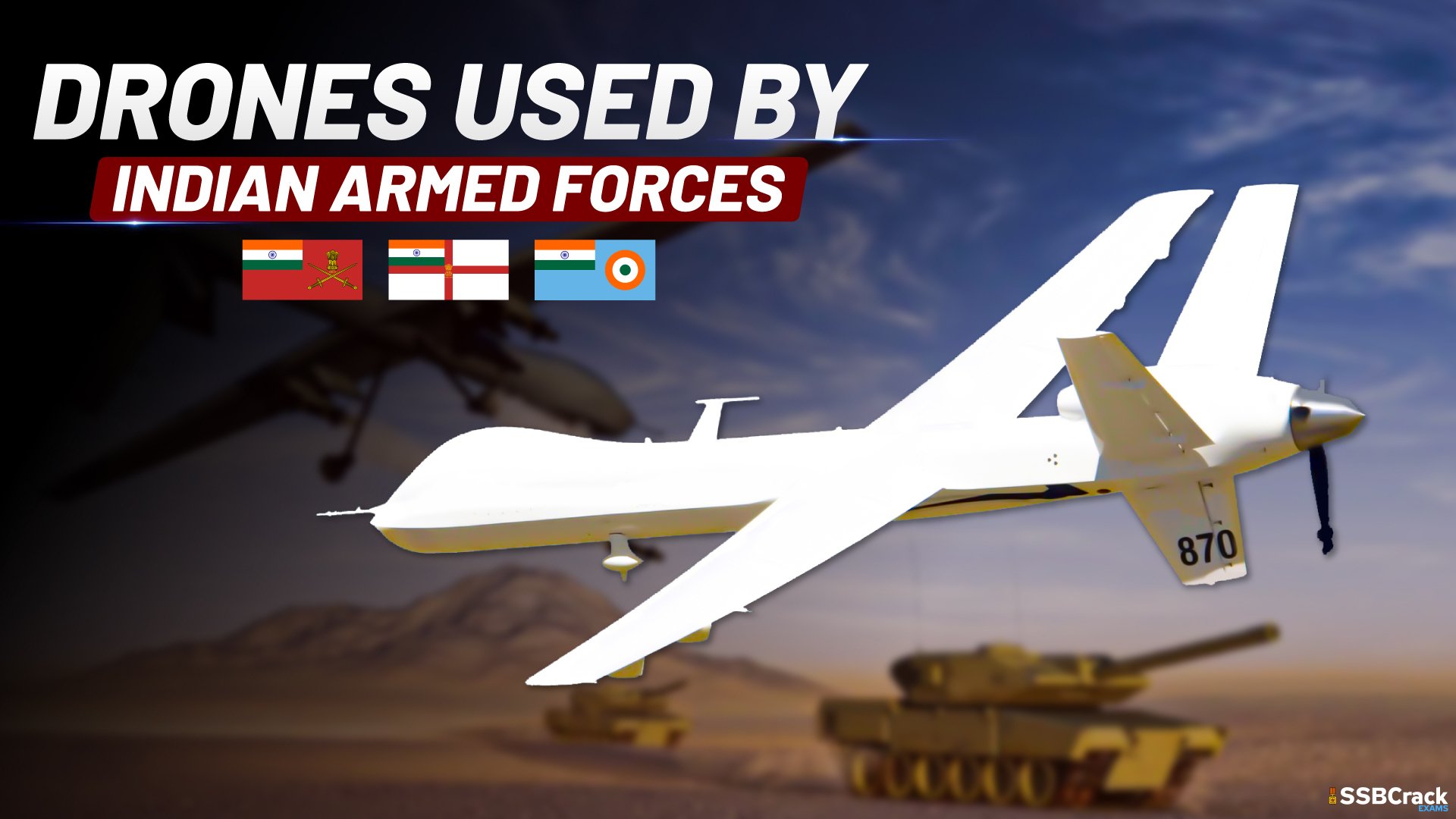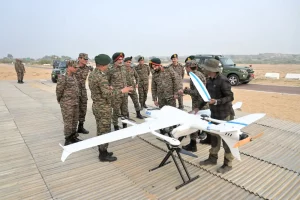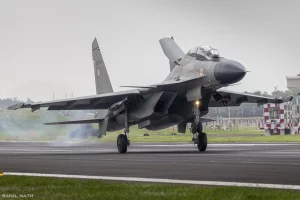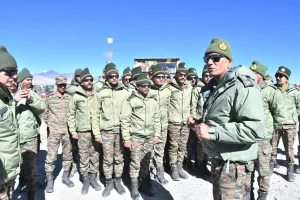What is a drone? An unmanned aerial vehicle (UAV), sometimes known as a drone, is a plane that flies without a human pilot, crew, or passengers. Unmanned aerial vehicles (UAVs) are part of an unmanned aircraft system (UAS), which also includes a ground-based controller and a communications system with the UAV.
UAV flight can be controlled remotely by a human operator, as in a remotely piloted aircraft (RPA), or with varying degrees of autonomy, such as autopilot help, up to completely autonomous aircraft with no human interaction.
Also Read: Importance Of UAVs, Drones, And RPAS For Indian Armed Forces
How are drones used in the military?
DRONES as Target Decoys
In some cases, a defense plan may need the use of drones as target decoys in order to deceive opponents and launch an attack from a different direction. Deploying target decoys wasn’t easy in the past, and it typically necessitated at least one soldier being inside the aircraft, despite the dangers associated in such operations. However, because UAVs and UACVs can be controlled remotely, this becomes considerably easier. However, because there is no room for error, military forces must enlist the help of devoted specialists with the requisite skills.
DRONES for Combat Missions
The payload and precision of UACVs are crucial in determining how successfully a combat drone can perform in a combat mission, ensuring that the drone hits the target and has the desired impact.
DRONES for Assessment and Supervision
Defense personnel must constantly observe and appraise the activities of their adversaries, putting their lives in danger in the process. Unmanned vehicles, on the other hand, may be utilized in a variety of ways to examine and analyze the enemy’s movements. It may also be used to locate current soldiers and establish communication with them, as well as pass on vital information. Because drones exist in a variety of sizes, sending one over with a powerful camera attached is a simple way to spy on the enemy’s soldiers. However, because they are controlled remotely, a sophisticated flight control system is required to keep them from being spotted.
Why does India need drones?
They are low-cost. They can be bought off the shelf or put together with store-bought components. The question of drone availability is strongly linked to this primitive yet devastating ensemble. Modern drones, which made their debut after the 9/11 attacks with the pricey Predator drones of the United States, are not readily available. Because the US carefully regulates the export of its Predator and Reaper Unmanned Combat Aerial Vehicles (UCAVs), this is the case. Only close military allies have access to them. China, Israel, and Turkey, on the other hand, have begun creating their own UCAVs, which they also sell internationally. For quasi-military regimes like Pakistan, developing economical means to project power with higher lethality at a lower risk for non-conventional operations is no longer impossible.India has a $866 million Unmanned Aerial Systems (UAS) sector, which effectively implies that drones are widely available in the country and may be weaponized by anyone, anywhere, and at any time.
Drones have a low Radar Cross Section (RCS), sluggish speed, and tiny size, giving them stealth and camouflage benefits in battle and making them difficult to identify and locate afterwards. Conventional radar systems aren’t designed to identify small flying objects, and even if they were, they may mistake a bird for a drone, causing the system to become overloaded. They have poor thermal and acoustical traces due to their tiny size.
LIST OF DRONES USED BY INDIAN ARMED FORCES
- DRDO Abhyas – The DRDO Abhyas is a high-speed expendable aerial target (HEAT) being developed for the Indian Armed Forces by the Aeronautical Development Establishment (ADE) of the Defence Research and Development Organisation (DRDO).
- DRDO Ghatak – Ghatak is a stealthy unmanned combat air vehicle (UCAV) being developed for the Indian Air Force by the Aeronautical Development Establishment (ADE) of the Defence Research and Development Organisation (DRDO). Aeronautical Development Agency will be in charge of the UCAV’s design (ADA)
- DRDO Archer
- India-US Joint ALUAV Target Drone
- RUAV 200
- Adani Hermes 900
- Trinetra UAV
- Hal Cats – The HAL Combat Air Teaming System program includes CATS Warrior. Its work is thought to have begun in early 2019 as part of a Public Private Partnership (PPP) between the state-owned HAL and a private Indian firm called Newspace R&D. HAL invested $400 million in CATS Warriors, and at Aero India 2021, a full-scale mock-up model was unveiled for the first time.
- DRDO Rustom – The DRDO Rustom is a Medium Altitude Long Endurance unmanned air vehicle (UAV) developed by the Defence Research and Development Organisation for the Indian Armed Forces’ three services: the Indian Army, Indian Navy, and Indian Air Force. Rustom is based on the NAL’s LCRA (Light Canard Research Aircraft), which was built in the 1980s by a team led by late Prof Rustom Damania. A new engine and structural improvements will be made to the UAV. The Heron UAVs in service with the Indian armed services will be replaced or supplemented by Rustom.
- TAPAS-BH-201 – Tactical Airborne Platform for Aerial Surveillance-Beyond Horizon-201, also known as TAPAS BH-201, is a high-altitude, long-endurance unmanned aerial vehicle (UAV) being developed in India by Aeronautical Development Establishment (ADE) on the lines of General Atomics’ MQ-1 Predator. After a three-year wait, the UAV made its first flight in November 2016. At the time, it was disclosed that the UAV’s name had been changed from Rustom-II to TAPAS-BH-201.
- DRDO Fluffy – The DRDO Fluffy was a target drone created and developed by the Aeronautical Development Establishment (ADE) of the Defence Research and Development Organisation in Bangalore in the early 1970s for use by the Indian Armed Forces. It could be launched from a maximum height of 30,000 feet and had a maximum endurance of 5 minutes. Fluffy’s manufacture was halted after the creation of the reusable Aerial Target DRDO Lakshya, which was easier and more cost-effective to use than Fluffy.
- DRDO Imperial Eagle – The Imperial Eagle is a light-weight mini-unmanned aerial vehicle (UAV) developed by India’s Aeronautical Development Establishment and backed by commercial vendors. The National Security Guard and the military forces will be its major customers.
- DRDO Kapothaka – Kapothaka was a reconnaissance technology demonstration mini-UAV. The Kapothaka (sometimes written Kapothaha) is said to be the forerunner of the Nishant UAV system.
- DRDO Lakshya – The Aeronautical Development Establishment (ADE) of the DRDO created Lakshya, an Indian remotely piloted high-speed target drone system. A derivative of the Lakshya-1 is utilized for combat reconnaissance and target acquisition in a stealthy manner. For live fire training, the drone is remotely operated by a ground control station and delivers realistic towed aerial sub-targets. The drone is launched from the ground or from a ship using a zero-length launcher, and it is recovered using a two-stage parachute system designed by ADE (DRDO) for land-based or sea-based recovery. The drone’s nose cone is crushable, absorbing the impact of landing and reducing damage. Depending on the objective, the flight route may be regulated or pre-programmed.
- DRDO Netra – The DRDO Netra is a light-weight, autonomous UAV developed in India for surveillance and reconnaissance missions. The Research and Development Establishment (R&DE) and IdeaForge, a Mumbai-based private enterprise, collaborated on it.
- DRDO Nishant – The DRDO Nishant is an unmanned aerial vehicle (UAV) created for the Indian Armed Forces by India’s Aeronautical Development Establishment (ADE), which is a component of the Defence Research and Development Organisation (DRDO). The Nishant UAV is primarily responsible for gathering intelligence over enemy territory, although it also performs reconnaissance, training, surveillance, target designation, artillery fire correction, damage assessment, ELINT, and SIGINT missions. The UAV has a four-hour and thirty-minute endurance. Nishant has finished the development stage as well as user testing.
- DRDO Ulka – Ulka is an Indian disposable target drone that is fired from the air. It was created by the DRDO’s Aeronautical Development Establishment laboratory (ADE). Ulka was formerly known just as MT (Missile Target). It was created with an ejector release device to be launched from subsonic or supersonic aircraft. With a rocket motor, it flew flights between 50 to 13,000 meters in altitude at speeds ranging from 0.7 to 1.4 Mach. It can use bogus radar signatures to replicate the speed and altitude characteristics of approaching, receding, or crossing aircraft.
- IAI-HAL NRUAV – The IAI-HAL NRUAV (Naval Rotary Unmanned Aerial Vehicle) is a rotorcraft project being built for the Indian Navy by Malat Solutions, an IAI branch in Israel, and HAL in India.
- Maraal
- NAL/ADE Black Kite – The NAL/ADE is a joint venture between the National Aeronautics Black Kite is an unmanned Micro Air Vehicle (MAV) technology demonstrator built by the DRDO’s Aeronautical Development Establishment (ADE) and the CSIRI’s National Aerospace Laboratories (NAL), with commercial vendors’ support. It’s one of the concepts being considered for the “National Program on Micro Air Vehicles” (NP-MICAV)
- NAL/ADE Golden Hawk – The ADE / NAL Golden Hawk is a technology demonstration for unmanned Micro Air Vehicles (MAVs) developed by the DRDO’s Aeronautical Development Establishment (ADE) and the CSIR’s National Aerospace Laboratories (NAL). It is one of the airframe designs being pursued for the “National Program on Micro Air Vehicles” and is based on Shashank Misra’s basic design (NP-MICAV)
- NAL/ADE Pushpak – The NAL / ADE Pushpak is an unmanned Micro Air Vehicle (MAV) technology demonstrator developed in collaboration with the DRDO’s Aeronautical Development Establishment (ADE) and the CSIRI’s National Aerospace Laboratories (NAL). It’s one of the concepts being considered for the “National Program on Micro Air Vehicles” (NP-MICAV).
- NAL Slybird – NAL National Aerospace Laboratories in India developed Slybird, a small unmanned aerial vehicle (UAV) (NAL). The police and military services will be its principal users. The NAL Slybird is a hand-launched aircraft with a soft landing capability. It has a one-hour endurance and a range of 10 kilometers. It has a service ceiling of 15000 feet and an operational height of 300 meters. A forward-looking pan-tilt day/infrared camera is installed on the ship.
- PAWAN UAV – The Pawan is an unmanned aerial vehicle (UAV) developed for the Indian Armed Forces and Israel Aircraft Industries by India’s ADE (Aeronautical Development Establishment), a part of DRDO. In terms of size and capability, the Pawan will be equivalent to Israel’s Elbit Hermes 180 and Silver Arrow drones. The 120-kilogram Pawan will be capable of monitoring day and night, with a five-hour endurance and a range of 150 kilometers.
Also Read: Top 10 Combat Drones In The World
Conclusion
These drones would be key to counter Pak rogue drones and Chinese spy drones. It is safe to assume that in the future, warfare using UAVs will be something India will have to deal with a lot more. Hence, the interest our defence establishment is taking in this sector is part of a well thought-out strategy.
Also Read:
- Indian Army Receives New Israeli Heron Drones To Keep An Eye On China
- Indian Army, Navy, Air Force Sign Deal For Inducting DRDO-Developed Anti-Drone System
- Indian Army Has Deployed Heron Drones At Line Of Actual Control To Track Chinese Army
- Indian Army To Get More Than 100 ‘Explosive-Laden Drones’ To Carry Balakot Type Missions



















